纺织品功能整理课件 (6)
第六章纺织品整理

第六章纺织品整理
(三)定幅设备及定幅工艺 定幅机种类及其组成: 种类:布夹拉幅机、针板拉幅机 组成:给湿、拉幅和烘干三部分 棉织物一般采用布夹拉幅机进行定幅加工
第六章纺织品整理
热风布夹拉幅机定幅
第六章纺织品整理
•6.2.1.2 机械预缩整理
•(一)织物缩水及缩水率的概念 •1、织物缩水:棉织物在织造和染整加工之后,形状往往处 于不稳定状态,具有潜在收缩性。织物在松弛状态下落水或 洗涤以后,会发生收缩变形,这种现象称为缩水。 2、缩水率:织物按规定的洗涤方法洗涤前后经向或纬向
第六章纺织品整理
2、织物缩水的主要原因在于纤维吸湿后呈现各 向异性溶胀,引起织缩增大。
织缩的概念:织物中纱线长度与织物长度之差 对织物长度的百分比。(引起织缩原因)
第六章纺织品整理
织缩增大而引起织物缩水的原因分析:
纱线在构成织物组织时的屈 曲起伏是产生织缩的原因。 纱线在织物中的屈曲越多、 屈曲波越大,织物的织缩就 越大。 当织物润湿时,纤维发生各 向异性溶胀,直径的增加程 度远大于长度的增加。
1928年开始; 二次大战后,洗可穿问世;
20世纪60年代:采用N-羟甲基酰胺类化合物-
甲醛问题;80发无甲醛防皱整理剂--热门。
第六章纺织品整理
织物产生折皱的原因: 从宏观上看:织物上折皱的形成是由于受外力时纤维弯曲变 形,放松后弯曲的纤维未能完全复原所造成的。
第六章纺织品整理
二、起毛(拉毛)整理 1、起毛:起毛整理是利用机械作用,将纤维末 端从纱线中均匀地拉出来,使织物表面产生一层 绒毛的加工过程。起毛也称拉毛或起绒。 2、起毛设备:单动式和双动式两种
•20~40 •只针辊
织物的功能整理(全部)PPT课件

7、苯酚类抗菌整理
四、广谱抗菌消炎内裤的开发实例
1、处理方法:有机硅-季铵盐与微溶性有机氮两次处理 2、加工过程:浸轧、浸渍或喷雾法,然后烘干再经热处理 3、适用织物:内裤、T恤、衬衫、内衣、床单等抗菌和防臭整理
五、效果验证
布片粘贴法 试管法
12
§1-5 抗霉腐整理
*与抗菌整理的不同
项目 用途不同
4
四、功能开发与人才需求
I型 T型 Π型
单一型
生物化学
延伸型 功能开发涉及学科
辐射化学 固体物理
两个专业基础
技术
医疗保健
经营管理(In china, everything is possible,
nothing is easy)
技术
X 型 复合型人才 五、讲课内容和学时安排 六、主要参考书
经营管理
名称
抗菌整理
抗霉腐整理
与人体皮肤接触的衣着、鞋帽 军用或产业用品
所处环境条件不同 室内
室外
一、整理手段
在织物上生成不溶性的抗霉腐物质、伯醇基化学变性、与纤维 素纤维中羟基结合形成共价键
二、抗霉腐机理 抗霉腐物质作用原理
不溶性 伯醇基化学变性 与纤维素纤维中羟基结合形成共价键后,使一些 能产生纤维素酶的真菌对它作用十分困难 13
PROVERB
All things in their being are good for something.
1
整体 概述
一 请在这里输入您的主要叙述内容
二
请在这里输入您的主要 叙述内容
三 请在这里输入您的主要叙述内容
2
课程名称
河北科技大学纺织服装学院 刘海文 Tel:83917709
织物的功能整理
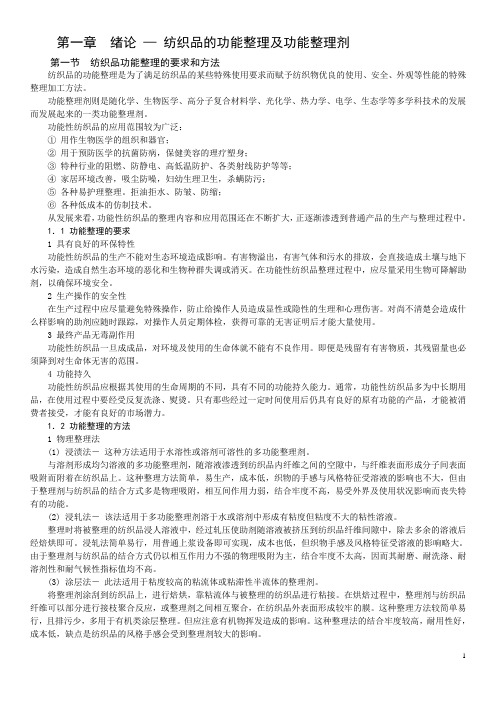
第一章绪论—纺织品的功能整理及功能整理剂第一节纺织品功能整理的要求和方法纺织品的功能整理是为了满足纺织品的某些特殊使用要求而赋予纺织物优良的使用、安全、外观等性能的特殊整理加工方法。
功能整理剂则是随化学、生物医学、高分子复合材料学、光化学、热力学、电学、生态学等多学科技术的发展而发展起来的一类功能整理剂。
功能性纺织品的应用范围较为广泛:①用作生物医学的组织和器官;②用于预防医学的抗菌防病,保健美容的理疗塑身;③特种行业的阻燃、防静电、高低温防护、各类射线防护等等;④家居环境改善,吸尘防噪,妇幼生理卫生,杀螨防污;⑤各种易护理整理。
拒油拒水、防皱、防缩;⑥各种低成本的仿制技术。
从发展来看,功能性纺织品的整理内容和应用范围还在不断扩大,正逐渐渗透到普通产品的生产与整理过程中。
1.1 功能整理的要求1 具有良好的环保特性功能性纺织品的生产不能对生态环境造成影响。
有害物溢出,有害气体和污水的排放,会直接造成土壤与地下水污染,造成自然生态环境的恶化和生物种群失调或消灭。
在功能性纺织品整理过程中,应尽量采用生物可降解助剂,以确保环境安全。
2 生产操作的安全性在生产过程中应尽量避免特殊操作,防止给操作人员造成显性或隐性的生理和心理伤害。
对尚不清楚会造成什么样影响的助剂应随时跟踪,对操作人员定期体检,获得可靠的无害证明后才能大量使用。
3 最终产品无毒副作用功能性纺织品一旦成成品,对环境及使用的生命体就不能有不良作用。
即便是残留有有害物质,其残留量也必须降到对生命体无害的范围。
4 功能持久功能性纺织品应根据其使用的生命周期的不同,具有不同的功能持久能力。
通常,功能性纺织品多为中长期用品,在使用过程中要经受反复洗涤、熨烫。
只有那些经过一定时间使用后仍具有良好的原有功能的产品,才能被消费者接受,才能有良好的市场潜力。
1.2 功能整理的方法1 物理整理法(1) 浸渍法-这种方法适用于水溶性或溶剂可溶性的多功能整理剂。
与溶剂形成均匀溶液的多功能整理剂,随溶液渗透到纺织品内纤维之间的空隙中,与纤维表面形成分子间表面吸附而附着在纺织品上。
织物的一般整理课件

•织物的一般整理
•5
柔软剂
表面活性剂类柔软剂 高分子聚合物类柔软剂
通过轧光机的机械压力、湿热的作用,借助于纤维的可塑性,使表面 纤
维呈现平行排列,以提高表面光滑平整度,对光产生规则的反射,进而提高
织物色泽的目的。
2、电光整理
电光整理机多为一硬一软的两辊式,硬辊可以加热,且表面上刻有与轧
辊轴心成一定角度的相互平行的斜线。整理时在织物表面轧上大量和织物表
面纱线捻向一致的平行线纹,掩盖了织物表面纤维不规则排列现象,从而对
第二节 各类织物一般整理要求
1、棉及棉型织物 一般都要进行拉幅整理,此外有些品种还需进行增白处理;
毛型织物进行柔软、电光、轧纹、起毛、割绒整理等;
2、丝织物 一般要进行定幅、轧光和蒸绸整理,有些品种还需进行增重、
硬挺整理等;
3、毛及毛型织物 精纺织物:要求整理后织物具有织纹清晰的表面; 粗纺织物:要求整理后织物表面具有短而平整的绒毛;
态下具有一定的可塑性能,将其门幅缓缓地拉幅至规定的尺寸,从 而消除部分内应力,调整径纬纱在织物中的状态,使织物的门幅整 齐划一、纬斜得到纠正以及获得较为稳定的尺寸,以符合印染成品 的规格要求。
•织物的一般整理
•2
2、设备 如布铗、针板拉幅机及皮带拉幅机
•织物的一般整理
•3
二、轧光、电光及轧纹
1、轧光整理
•织物的一般整理
•13
6、纺织品整理

第一节 概述
•ቤተ መጻሕፍቲ ባይዱ一、概念
• 纺织品整理是指通过物理、化学联合方法和一定 的设备,改善纺织品外观和内在品质,提高服用 性能或其它应用性能或赋予特殊性功能的加工过 程。 • 目的: • 1、尺寸形态稳定 • 2、增进外观 • 3、改善手感 • 4、提高耐用性能 • 5、赋予特殊性能
• 二、整理的分类
在外力作用下,纤维发生弯曲变形, 外力放松后,不能恢复原样,即产生 折皱。
拉伸
压缩
• 机理:树脂整理剂能够与纤维素分子中的羟基结合而 形成共价键,或者沉积在纤维分子之间,从而限制了 大分子链间的相对滑动,提高织物的防皱性能,同时 也可获得防缩效果。 • (二)树脂整理的工艺 • 1、浸轧树脂整理液 • 轧液率:轧液率越低越好, 一般70%~80% • 轧液率高的缺点: 轧液率高的缺点: • 能量浪费 • 烘干时发生泳移,产生表面树脂 • 手感僵硬 • 弹性差 • 强度低 • 摩擦牢度差
• 2、预烘
– 目的:使初缩体均匀渗透到纤维内部 – 意义:直接影响树脂分布和整理品的质量 – 原理:浸轧后,浓度外大于内,预烘时,依 浓度梯度,使树脂向内扩散。 – 理想状态:水分蒸发速率=整理剂分子向纤 维内部扩散速率 – 有利方面:烘干有利渗透,因为表面浓度高, 形成向内渗透的浓度梯度 – 不利方面:水分干到一定程度,表面先干, 里面的水分往外跑,把树脂带出来,即发生 表面泳移,形成表面树脂
• 3、拉幅烘干 • 4、焙烘
– 使初缩体与纤维发生交联反应
• 5、皂洗、烘干
– 洗去如下物质 • 未反应的树脂初缩体 • 催化剂 • 表面树脂 • 甲醛 • 甲胺(有鱼腥味)
• (三)低甲醛和无甲醛树脂整理剂和整 理工艺 • 1、低甲醛整理剂及整理工艺 • 用多元醇醚化可制得低甲醛整理剂,甲 醛含量可低于150mg/L • 2、无甲醛整理剂及整理工艺 • 1)丁烷四羧酸 • 白色粉末状固体,在水中溶解度130g/L, 水溶液pH=2
纺织品功能整理
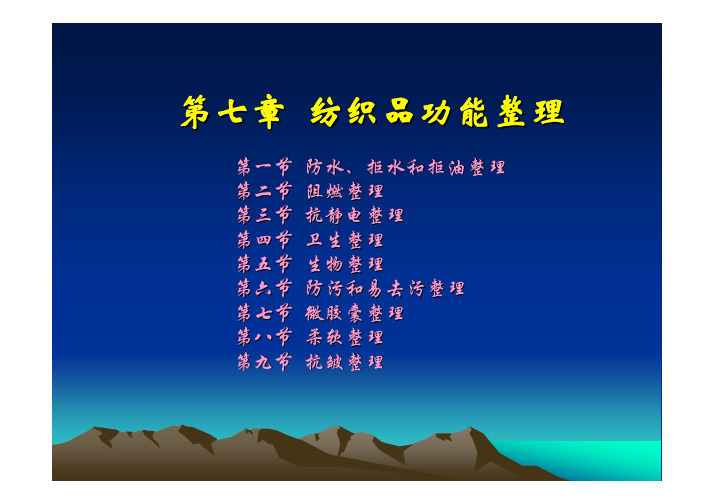
第七章纺织品功能整理第一节防水、拒水和拒油整理第二节阻燃整理第三节抗静电整理第四节卫生整理第五节生物整理第六节防污和易去污整理第七节微胶囊整理第八节柔软整理第九节抗皱整理第七章要点第一节防水、拒水和拒油整理拒水拒油原理rθr sr Lr sL表面粗糙拒水拒油条件=r<0 珠缩失,r L、r s L形成常见拒水拒油剂:拒水拒油剂:整理工艺:烘干40℃,70%轧余率150℃,3min.有机硅类拒水剂与有机硅柔软剂混用工艺流程多浸多轧整理液:甲基含氢硅烷乳液30g/L羟基硅烷乳液70g/L胺化环氧交联剂14.2g/L醋酸锌10.8g/L氯氧化锆 5.4g/L一乙醇胺 4.5g/L水至1000拒油整理工艺:整理液:有机氟FC-208 133g/LVelan PF 80乙醇80醋酸钠26水至1000拒水拒油性能测试:第二节阻燃整理纺织品的燃烧性:化、熔融氧化燃烧模式纤维热裂解玻璃化温度(Tg)熔融温度(Tm)热裂解温度(Tp)燃烧温度(Tc)LOI = 燃烧热火焰最高温度需氧指数LOI燃烧骨架效应:阻燃方法二、阻燃机理棉织物在~200℃开始裂解,500℃以上炭化,其间温度分解形成可燃物。
棉阻燃剂涤纶的阻燃机理:气体焦油状物残渣裂解成分30种以上。
产生烟雾火焰反应ROOH RO ROO 2 2 OH + CO CO涤纶阻燃剂MX M + X MX HX + M‘+ HX H OH + HX H 截获H ·、·OH ,阻燃。
阻燃剂:阻燃剂金属氧化物、卤化物硼砂磷酸盐有机磷阻燃剂阻燃剂使用:多种复合,综合效果。
阻燃整理工艺:1、棉织物的阻燃整理不耐洗阻燃整理半耐洗阻燃整理耐洗性燃整理工艺:浸轧42、涤纶织物的阻燃整理3、涤/棉混纺织物阻燃整理纺织品阻燃性能测试方法:第三节抗静电整理---摩擦带电序+抗静电方法:-P-ONa OHO抗静电整理剂及其应用: 1、非耐久性抗静电整理剂2、耐久性抗静电剂静电大小的测量:第四节卫生整理卫生整理目的:微生物细菌---原核细胞型真菌---真核细胞型病毒---非细胞型致病性有益型抗菌机制卫生整理剂和卫生整理工艺: 1、有机硅季铵盐抗菌整理剂DC-5700℃)织物增重0.1~1%2、二苯醚类抗菌剂3、芳香族卤化物抗菌剂4、其它抗菌剂卫生整理测试:养基上,隔时检查菌落数,与空白对比。
纺织品功能整理
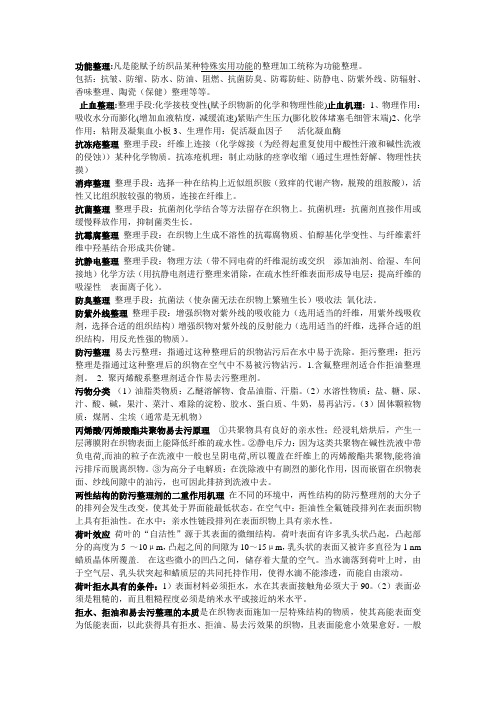
功能整理:凡是能赋予纺织品某种特殊实用功能的整理加工统称为功能整理。
包括:抗皱、防缩、防水、防油、阻燃、抗菌防臭、防霉防蛀、防静电、防紫外线、防辐射、香味整理、陶瓷(保健)整理等等。
止血整理:整理手段:化学接枝变性(赋予织物新的化学和物理性能)止血机理:1、物理作用:吸收水分而膨化(增加血液粘度,减缓流速)紧贴产生压力(膨化胶体堵塞毛细管末端)2、化学作用:粘附及凝集血小板3、生理作用:促活凝血因子-----活化凝血酶抗冻疮整理整理手段:纤维上连接(化学嫁接(为经得起重复使用中酸性汗液和碱性洗液的侵蚀))某种化学物质。
抗冻疮机理:制止动脉的痉挛收缩(通过生理性舒解、物理性扶摸)消痒整理整理手段:选择一种在结构上近似组织胺(致痒的代谢产物,脱羧的组胺酸),活性又比组织胺较强的物质,连接在纤维上。
抗菌整理整理手段:抗菌剂化学结合等方法留存在织物上。
抗菌机理:抗菌剂直接作用或缓慢释放作用,抑制菌类生长。
抗霉腐整理整理手段:在织物上生成不溶性的抗霉腐物质、伯醇基化学变性、与纤维素纤维中羟基结合形成共价键。
抗静电整理整理手段:物理方法(带不同电荷的纤维混纺或交织添加油剂、给湿、车间接地)化学方法(用抗静电剂进行整理来消除,在疏水性纤维表面形成导电层:提高纤维的吸湿性表面离子化)。
防臭整理整理手段:抗菌法(使杂菌无法在织物上繁殖生长)吸收法氧化法。
防紫外线整理整理手段:增强织物对紫外线的吸收能力(选用适当的纤维,用紫外线吸收剂,选择合适的组织结构)增强织物对紫外线的反射能力(选用适当的纤维,选择合适的组织结构,用反光性强的物质)。
防污整理易去污整理:指通过这种整理后的织物沾污后在水中易于洗除。
拒污整理:拒污整理是指通过这种整理后的织物在空气中不易被污物沾污。
1.含氟整理剂适合作拒油整理剂。
2. 聚丙烯酸系整理剂适合作易去污整理剂。
污物分类(1)油脂类物质:乙醚溶解物、食品油脂、汗脂。
(2)水溶性物质:盐、糖、尿、汁、酸、碱,果汁、菜汁、难除的淀粉、胶水、蛋白质、牛奶,易再沾污。
纺织品整理功能ppt课件

阻燃毛毡
抗菌防腐木乃伊
抗菌产品
抗菌产品
床上用品
羽绒被
抗菌产品
银纤维袜
竹纤维袜
抗静电、导电纤维及纱线
抗静电纤维
ห้องสมุดไป่ตู้
合金锗纤维
镀银导电纤维
抗静电、导电纤维及纱线
碳纤维
金属纤维
抗静电产品
抗静电针刺过滤毯
防紫外线产品
儿童冲浪服
防紫外面料
抗紫外线纤维及纺织品
防辐射产品
2、服装功能的发展历史
第一阶段:遮体、保暖。 第二阶段:织物延伸的穿着功能(易保养功能
第八章 功能整理新技术介绍 2.0学时
总复习
3.0学时
考试
3.0学时
5、基础知识介绍
纺织纤维的分类 服装面料的加工过程
纺织纤维的分类
天然纤维 化学纤维
棉纤维
纤维素纤维
麻纤维:苎麻、亚麻、黄麻、大麻等
丝纤维:桑蚕丝、柞蚕丝
蛋白质纤维
毛纤维:羊毛、兔毛、骆驼毛、马海毛等
人造纤维:粘胶纤维、醋酯纤维、铜氨纤维
性的有机结合。 主要依靠印染后整理加工。缺少从纤维原料、纺纱
织造、印染、服装一条龙全方位考虑,造成产品功 能性不耐久,功能性指标不高,技术含量低,易被 仿冒而低价竞争。 功能性产品缺乏统一的质量标准和检测方法。 功能性加工的环保和安全问题尚未解决。
我国功能性产品的开发思路主要依赖于助剂加工 ,不能做到多学科交叉研发,因而,产品技术含 量低、档次低,缺乏技术创新和价值创新。
合成纤维:涤纶、锦纶、腈纶、氯纶、维纶、氨纶等
服装面料的加工过程
1、纺纱→织造——纺织厂 2、染整加工——印染厂
纺织品功能整理
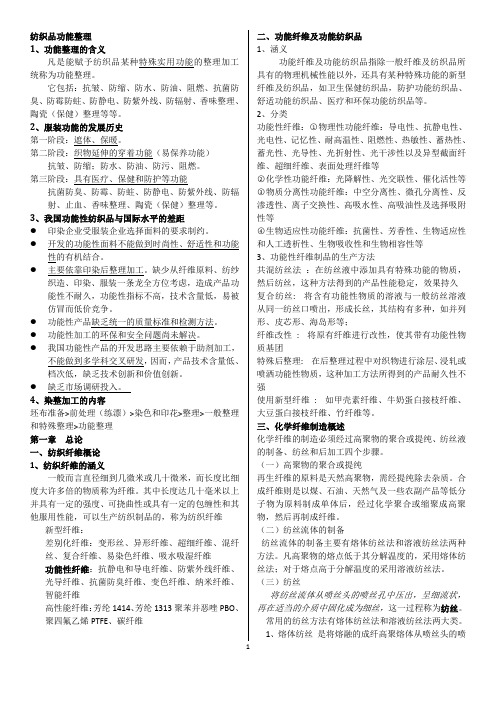
纺织品功能整理1、功能整理的含义凡是能赋予纺织品某种特殊实用功能的整理加工统称为功能整理。
它包括:抗皱、防缩、防水、防油、阻燃、抗菌防臭、防霉防蛀、防静电、防紫外线、防辐射、香味整理、陶瓷(保健)整理等等。
2、服装功能的发展历史第一阶段:遮体、保暖。
第二阶段:织物延伸的穿着功能(易保养功能)抗皱、防缩;防水、防油、防污、阻燃。
第三阶段:具有医疗、保健和防护等功能抗菌防臭、防霉、防蛀、防静电、防紫外线、防辐射、止血、香味整理、陶瓷(保健)整理等。
3、我国功能性纺织品与国际水平的差距●印染企业受服装企业选择面料的要求制约。
●开发的功能性面料不能做到时尚性、舒适性和功能性的有机结合。
●主要依靠印染后整理加工。
缺少从纤维原料、纺纱织造、印染、服装一条龙全方位考虑,造成产品功能性不耐久,功能性指标不高,技术含量低,易被仿冒而低价竞争。
●功能性产品缺乏统一的质量标准和检测方法。
●功能性加工的环保和安全问题尚未解决。
●我国功能性产品的开发思路主要依赖于助剂加工,不能做到多学科交叉研发,因而,产品技术含量低、档次低,缺乏技术创新和价值创新。
●缺乏市场调研投入。
4、染整加工的内容坯布准备>前处理(练漂)>染色和印花>整理>一般整理和特殊整理>功能整理第一章总论一、纺织纤维概论1、纺织纤维的涵义一般而言直径细到几微米或几十微米,而长度比细度大许多倍的物质称为纤维。
其中长度达几十毫米以上并具有一定的强度、可挠曲性或具有一定的包缠性和其他服用性能,可以生产纺织制品的,称为纺织纤维新型纤维:差别化纤维:变形丝、异形纤维、超细纤维、混纤丝、复合纤维、易染色纤维、吸水吸湿纤维功能性纤维:抗静电和导电纤维、防紫外线纤维、光导纤维、抗菌防臭纤维、变色纤维、纳米纤维、智能纤维高性能纤维:芳纶1414、芳纶1313聚苯并恶唑PBO、聚四氟乙烯PTFE、碳纤维二、功能纤维及功能纺织品1、涵义功能纤维及功能纺织品指除一般纤维及纺织品所具有的物理机械性能以外,还具有某种特殊功能的新型纤维及纺织品,如卫生保健纺织品,防护功能纺织品、舒适功能纺织品、医疗和环保功能纺织品等。
纺织品功能整理 ppt课件
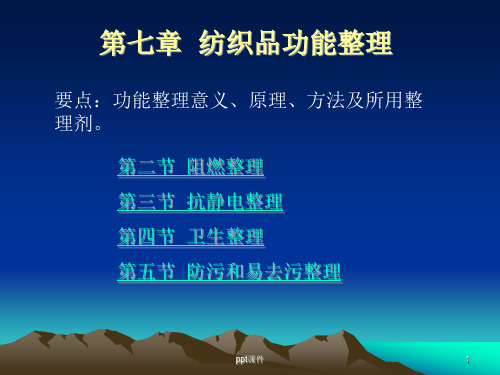
熔融温度(Tm)
热裂解温度(Tp)
燃烧温度(Tc)
ppt课件
16
需氧指数LOI
纺织品燃烧需氧指数(限氧指数):LOI
指在N2、O2混合气体中,纺织品保持烛状燃烧
所需O2的最小体积分数。
LOI =
O2 N2+O2
ppt课件
7
三、整理工艺
1、吡啶类拒水剂----耐久 维兰PF:
工艺流程:
150℃,3min.
二浸二轧
40℃,70% 轧余率
烘干 焙烘 皂洗 水洗
整理液处方:维兰PF 60g/L 乙醇 60ml
(接受HCl) NaAc 20g/L 水 至1000
烘干
ppt课件
有机硅类拒水剂
含氢硅氧烷:-Si-H ,反应、交联成膜,为改善手 感,与端羟基有机硅混用。
截获H ·、 ·OH, 阻燃。
ppt课件
24
3、阻燃剂
阻燃元素
Ⅲ:硼、铝 Ⅳ:钛、锆 Ⅴ:氮、磷、锑 Ⅶ:氯、溴
耐久型 阻燃剂 非耐久型
无机 有机
阻燃剂使用:
金属氧化物、卤化 物
多种复合,综合效果。
硼砂-硼酸 磷酸盐
有机磷阻燃剂
ppt课件
25
三、阻燃整理工艺
1、棉织物的阻燃整理
不耐洗阻燃整理:
硼砂:硼酸:磷酸氢二铵= 7:3:5 或 5:5:1 织物浸轧烘干,增重10~15%即有效。
对纺织品的服用者产生医疗作用,如皮肤病治愈 等。
防止纺织品被霉腐菌降解。
在抗菌同时与人体接触织物安全、无毒性。
纺织品功能整理
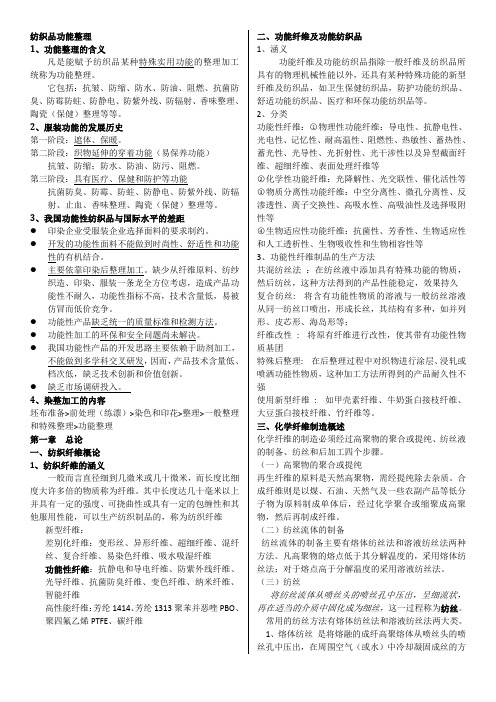
纺织品功能整理1、功能整理的含义凡是能赋予纺织品某种特殊实用功能的整理加工统称为功能整理。
它包括:抗皱、防缩、防水、防油、阻燃、抗菌防臭、防霉防蛀、防静电、防紫外线、防辐射、香味整理、陶瓷(保健)整理等等。
2、服装功能的发展历史第一阶段:遮体、保暖。
第二阶段:织物延伸的穿着功能(易保养功能)抗皱、防缩;防水、防油、防污、阻燃。
第三阶段:具有医疗、保健和防护等功能抗菌防臭、防霉、防蛀、防静电、防紫外线、防辐射、止血、香味整理、陶瓷(保健)整理等。
3、我国功能性纺织品与国际水平的差距●印染企业受服装企业选择面料的要求制约。
●开发的功能性面料不能做到时尚性、舒适性和功能性的有机结合。
●主要依靠印染后整理加工。
缺少从纤维原料、纺纱织造、印染、服装一条龙全方位考虑,造成产品功能性不耐久,功能性指标不高,技术含量低,易被仿冒而低价竞争。
●功能性产品缺乏统一的质量标准和检测方法。
●功能性加工的环保和安全问题尚未解决。
●我国功能性产品的开发思路主要依赖于助剂加工,不能做到多学科交叉研发,因而,产品技术含量低、档次低,缺乏技术创新和价值创新。
●缺乏市场调研投入。
4、染整加工的内容坯布准备>前处理(练漂)>染色和印花>整理>一般整理和特殊整理>功能整理第一章总论一、纺织纤维概论1、纺织纤维的涵义一般而言直径细到几微米或几十微米,而长度比细度大许多倍的物质称为纤维。
其中长度达几十毫米以上并具有一定的强度、可挠曲性或具有一定的包缠性和其他服用性能,可以生产纺织制品的,称为纺织纤维新型纤维:差别化纤维:变形丝、异形纤维、超细纤维、混纤丝、复合纤维、易染色纤维、吸水吸湿纤维功能性纤维:抗静电和导电纤维、防紫外线纤维、光导纤维、抗菌防臭纤维、变色纤维、纳米纤维、智能纤维高性能纤维:芳纶1414、芳纶1313聚苯并恶唑PBO、聚四氟乙烯PTFE、碳纤维二、功能纤维及功能纺织品1、涵义功能纤维及功能纺织品指除一般纤维及纺织品所具有的物理机械性能以外,还具有某种特殊功能的新型纤维及纺织品,如卫生保健纺织品,防护功能纺织品、舒适功能纺织品、医疗和环保功能纺织品等。
织物的功能整理(全部)PPT课件

绪论
一、整理的范畴 织物后整理
广义:离开织机后一切加工过程 印染加工
狭义:练漂、染色、印花后的加工过程(含功能整理)
二、功能整理的含义与范畴 含义:凡能赋予纺织品某种实用功能的整理加工统称为功能整理 使织物具有医疗、保健和抵御外侵的功能 范畴:使织物的穿着功能延伸 功能性涂层整理
三、功能开发的重要性 是工业发展的需要
三、常用整理方法
氢氧化铜氨
(一)不溶性铜剂整理法
环烷酸铜 8-羟基喹啉铜
铜-锆氧衍生物 不溶性物质 (二)锡、锌、铬和汞剂整理法
六价铬盐很容易水解,应用价值不大
(三)酚类整理法
(四)接枝和变性整理法
伯醇基化学变性
(五)树脂整理法
与纤维素纤维中羟基结合形成共价键
14
§1-6 抗静电整理
静电带来的麻烦:P41~42
Fe 3+—酞菁衍生物溶解于碱性水溶液中,附于纤维
人造氧化酶
工作原理图
活性中心Fe 3+
O2氧化 还原
Fe 2+
臭气中硫化氢 氧化分解
17
二、防臭机理
积极法 消极法
杜绝臭味生成 吸附臭气 氧化臭气
§1-8 防昆虫整理
一、整理手段 消极的 积极的
驱赶法 灭杀法(常用于毛织物防蛀整理、棉麻织物的防蚊整理)
10
§1-4 抗菌整理
一、整理手段 抗菌剂化学结合等方法留存在织物上
对人体无害的
二、抗菌机理
抗菌剂直接作用或缓慢释放作用,抑制菌类生长 三、常用整理方法及所适用织物
1、 *有机硅—季铵盐抗菌整理 (加工方法:浸渍法、浸轧法; 适用织物:睡衣、被褥、内衣、内裤、运动服、工作服、袜子 及毛巾)
- 1、下载文档前请自行甄别文档内容的完整性,平台不提供额外的编辑、内容补充、找答案等附加服务。
- 2、"仅部分预览"的文档,不可在线预览部分如存在完整性等问题,可反馈申请退款(可完整预览的文档不适用该条件!)。
- 3、如文档侵犯您的权益,请联系客服反馈,我们会尽快为您处理(人工客服工作时间:9:00-18:30)。
Different ways that low energy surfaces
mechanical incorporation of the water-repellent products in or wateron the fibre and fabric surface, in the fibre pores and in the spacing between the fibres and the yarns. Examples : paraffin emulsions. chemical reaction of the repellent material with the fibre surface. Examples : fatty acid resins. formation of a repellent film on the fibre surface. Examples : silicone and fluorocarbon products. use special fabric constructions like stretched polytetrafluoroethylene films (Goretex), films of hydrophilic polyester (Sympatex) and microporous coatings (hydrophilic modified polyurethanes).
6.3 Repellent chemistry
6.3.1 Paraffin repellents
6.3.2 Stearic acid–melamine acid– repellents
6.3.3 Silicone water repellents
6.3.4 Fluorocarbon-based Fluorocarbonrepellents
6 Repellent finishes
outline
6.1 Introduction 6.2 Mechanisms of repellency 6.3 Repellent chemistry 6.4 Evaluation of textiles treated with repellent finishes 6.5 Troubleshooting for repellent finishes and particularities
6.1 Introduction
6.2 ms of repellency
Repellent finishes achieve their properties by reducing the free energy at fibre surfaces.
If the adhesive interactions between a fibre and a drop of liquid placed on the fibre are greater than the internal cohesive interactions within the liquid, the drop will spread. If the adhesive interactions between the fibre and the liquid are less than the internal cohesive interactions within the liquid, the drop will not spread.
